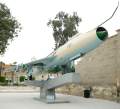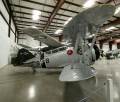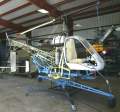Aircraft and Military Museums
Classic Rotors
Edwards Air Force Base
Egyptian National Military Museum

|
Appropriately enough, the Egyptian National Military Museum is located within the grounds of the Citadel in Cairo, which has hosted the military garrisons of the Arab rulers of Egypt, followed by the Ottoman Turks, the French and the British. The Citadel is a tourist destination in its own right, with great views over the city and attractions like the mosque of Mohammed Ali. |

|
Here's a rarity, a Sukhoi Su-7 jet fighter/bomber which served with the Egyptian Air Force. An interesting aircraft, though I'm not sure how its pitot tube got so bent! |
Grissom Air Museum
Hiller Aviation Museum
Imperial War Museum at Duxford
|
The Imperial War Museum facility at Duxford airfield near Cambridge doesn't just house military aircraft. As well as having the world's first jet airliner, the Comet, this might also be the only place where you'll get to walk through the world's most sophisticated jet airliner, the Concorde. |

|
Keith Park Museum
Kenosha Military Museum
London Science Museum
|
There are British fighter aircraft like the Spitfire and Hurricane, as well as the Supermarine Spitfire floatplane, a civilian race plane which was developed to become the Spitfire fighter. |

|
National Warplane Museum

|
Some of the exhibits are sure to bring a smile to your face. |
|
If you want to lay out a bit of cash, say $US350, then you can even take a ride in the museum's restored World War Two B-17 bomber. |

|
Nellis Air Force Base Threat Training Facility

|
The very existence of the Threat Training Facility at Nellis AFB near Las Vegas was classified until 1993, and it's still not the easiest place to visit, unless you're on active duty with the Air Force. And little wonder, since this place contains $70 million of enemy military hardware, including aircraft like the MiG-17, MiG-21, MiG-23 and MiG-29. |
Norfolk Air Power Park

|
This has to be the saddest of Virginia's three big aviation museums, with an excellent collection of space rockets, missiles and 1950s and 1960s American military jets. |
|
Here they all are, outside and rusting in Virginia's steamy air, millions of dollars of irreplaceable history like this F-100 Super Sabre rotting for lack of funds to properly house and restore them. |

|
Oshkosh Experimental Aircraft Association Museum
|
There are some good non-aircraft displays, too, like this original spare shell casing from the World War 2 "Fat Man" atomic bomb. |

|
Palm Springs Air Museum
Pearl Harbor
|
Most people know about the USS Arizona memorial in Pearl Harbor, hovering above the ship of the same name which was sunk by the Japanese, and caused America to immediately enter World War Two... |

|

|
...however, Pearl Harbor has some less well known military attractions, like the USS Missouri, the American battleship on which the Japanese surrendered at the end of the war... |
Planes of Fame at Valle
|
There's also a US Navy F3F biplane fighter, immediate predecessor of the F4F Wildcat fighter which America used in the early days of the war in the Pacific. |

|
Quantico Marine Corp Air-Ground Museum
|
It's an air-ground museum, so of course they also have some ground-borne weaponry such as self-propelled guns and tanks. |

|

|
There are also such rare items as the F9F Panther, the first navy jet fighter to enter combat, and American military helicopters from the Korean War. |
Royal Air Force Museum at Hendon
|
The official Royal Air Force museum at Hendon, in North London, is filled with rare British world war two aircraft which you won't see anywhere else, like this Boulton-Paul Defiant, a fatally flawed fighter design which had a gun turret at the rear but no forward-firing armament. |

|

|
This German world war two jet fighter, the Heinkel He162 Salamander (or Volksjaeger, "people's fighter") is also very unusual, having entered service very near the end of the war. In addition to the Salamander, Hendon has quite a few different aircraft in its collection of German world war two aircraft. |
Royal New Zealand Air Force Museum at Wigram

|
The now decommissioned Wigram Air Force base in the South Island city of Christchurch contains the official Royal New Zealand Air Force museum. |
|
You can check out planes which have served in the New Zealand Air Force from World War II up until the present day. |

|

|
Past Air Force hands might get bleary eyed looking at some of the old and old-but-still-in-use aircraft used in training and during New Zealand's overseas wars. |
Russian Air Force Museum at Monino

|
Highlights of the museum's comprehensive collection of Russian air force aircraft, including transport aircraft, fighters and bombers. There are planes from world war two right through the years of the Cold War, and include many of the prototypes used to pioneer well-known aircraft in the Soviet inventory, as well as developmental aircraft which never went into production, amongst which are ski equipped supersonic jet fighters, naval VTOL fighters as well as record breaking aircraft like the largest propeller planes to enter service, and the largest and fastest supersonic airliner ever built. |
San Diego International Aerospace Hall of Fame
Smithsonian Air and Space Museum
United States Air Force Museum at Dayton

|
The official USAF museum in Dayton, Ohio, is the world's premier military aircraft museum, with oodles of historically significant aircraft from the beginnings of air power in the United States up to the present day. There's also a rarely seen selection of enemy aircraft - German, Italian and Russian. |
|
There are many weird and wonderful aircraft here, from the "Twin Mustang" to the "Goblin" Parasitic Fighter to the "Tacit Blue" prototype of today's stealth fighter and bomber. |

|
USS Hornet
|
There's also an F-8U Crusader, a type of aircraft nicknamed "The Gator" because of the tendency of its powerful engine to suck in anything within a 20 foot radius. |

|
USS Intrepid
|
San Francisco has a submarine across the Bay from the Hornet, but here all you have to do is go across the pier, to where the USS Growler, an early guided missile submarine, is berthed. |

|
Vietnamese Air Force Museum in Hanoi
|
The Vietnamese Air Force Museum in Hanoi isn't on the list of attractions for most tourists, but it's well worth visiting if you're a military aviation enthusiast or someone with a personal connection to the Vietnam war. There's a group of about 20 aircraft at the museum, all parked outside, with three MiG jets in pride of place near the main gate. |

|
Virginia Air and Space Center

|
The Virginia Air and Space Center has a good selection of America's leading military aircraft from the 1960s and 1970s. |
|
It also serves as the visitor center for the NASA Langley Research Center, with various space relics and experimental aircraft, such as this British "Kestrel", the forerunner of the Harrier jump jet. |
|
Yankee Air Museum
|
The Yankee Air Museum has some good large aircraft like the Stratofortress, Argosy and Privateer, but it really excels with its collection of American Cold War jet fighters. Here you'll find early jets like a T-33 Shooting Star, an F-84F Thunderstreak, an F-86 Sabre, an F-101 Voodoo, an F-102 Delta Dagger and an F-105 Thunderchief. |

|
Yasukuni-jinja Yushukan War Museum

|
The Yasukuni-jinja Shinto shrine near the Imperial Palace in Tokyo is dedicated to "the restoration of peace in the Empire", and in particular, to the laying to rest of the spirits of the two and a half million Japanese who have died during all of Japan's wars. The attached Yushukan war museum has exhibits such as this locomotive, the first to traverse the Thai-Burma railway, which was built by prisoners of war and made famous in the movie "Bridge Over the River Kwai". |

|
There are also examples of Japanese equipment recovered after the war from the Pacific Theater, like a tank from Iwo-Jima and this extremely rare Suisei "Comet" dive bomber. |




















































